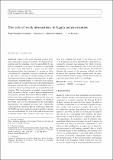The role of weak interactions in lignin polymerization
Author(s)
Sánchez-González, Ángel; Dobado, J. A.; Martin-Martinez, Francisco J.
Download894_2017_3257_ReferencePDF.pdf (17.59Mb)
PUBLISHER_POLICY
Publisher Policy
Article is made available in accordance with the publisher's policy and may be subject to US copyright law. Please refer to the publisher's site for terms of use.
Terms of use
Metadata
Show full item recordAbstract
Lignin is the most abundant natural polymer composed by aromatic moieties. Its chemical composition and its abundance have focused efforts to unlock its potential as a source of aromatic compounds for many years. The lack of a proper way for lignin de-polymerization has hampered its success as a natural solution for commodity aromatic chemicals, which is also due to the lack of understanding of the underlying mechanisms of lignin polymerization. A fuller fundamental understanding of polymerization mechanisms could lead to improvements in de-polymerization strategies, and therefore a proper methodology and a predictive theoretical framework are required for such purpose. This work presents a complete computational study on some of the key steps of lignin polymerization mechanisms. Density functional theory (DFT) calculations have been performed to evaluate the most appropriate methodology and to compute the chemical structures and reaction enthalpies for the monolignol dimerization, the simplest key step that controls the polymerization. Quantum theory of atoms in molecules (QTAIM) has been applied to understand the coupling reaction mechanisms, for which the radical species and transition states (TSs) involved have been characterized. The coupling that leads to the formation of the β–O–4 linkage has been theoretically reproduced according to proposed mechanisms, for which weak interactions have been found to play a key role in the arrangement of reactants. The hydrogen bond formed between the oxygen of the phenoxy radical, and the alcohol of the aliphatic chain, together with the interaction between aromatic rings, locates the reactants in a position that favors such β–O–4 linkage.
Graphical Abstract
QTAIM analysis of the complex between coumaryl and coniferyl alcohols. It emphasizes the importance of weak interactions during the formation of beta-O-4 linkages in the polymerization of lignin.
Date issued
2017-02Department
Massachusetts Institute of Technology. Department of Civil and Environmental EngineeringJournal
Journal of Molecular Modeling
Publisher
Springer Berlin Heidelberg
Citation
Sánchez-González, Ángel, Francisco J. Martín-Martínez, and J. A. Dobado. “The Role of Weak Interactions in Lignin Polymerization.” Journal of Molecular Modeling 23.3 (2017): n. pag.
Version: Author's final manuscript
ISSN
1610-2940
0948-5023